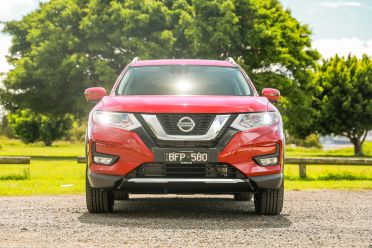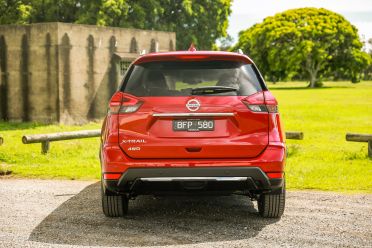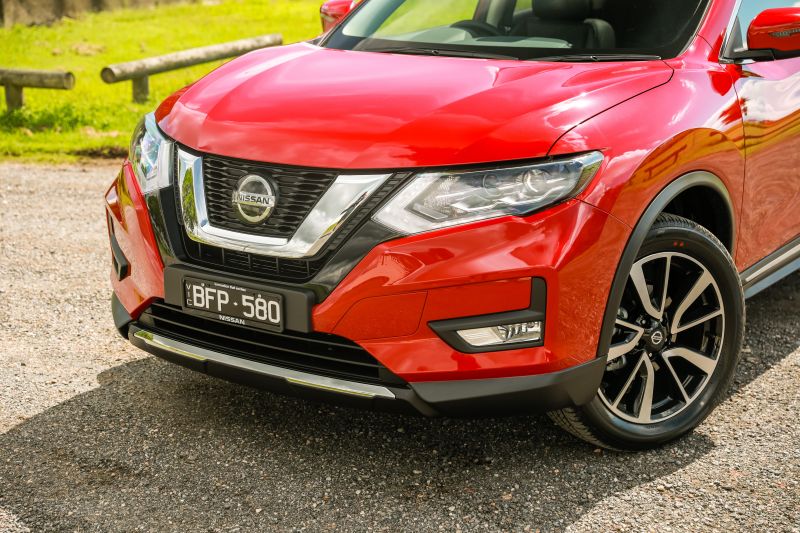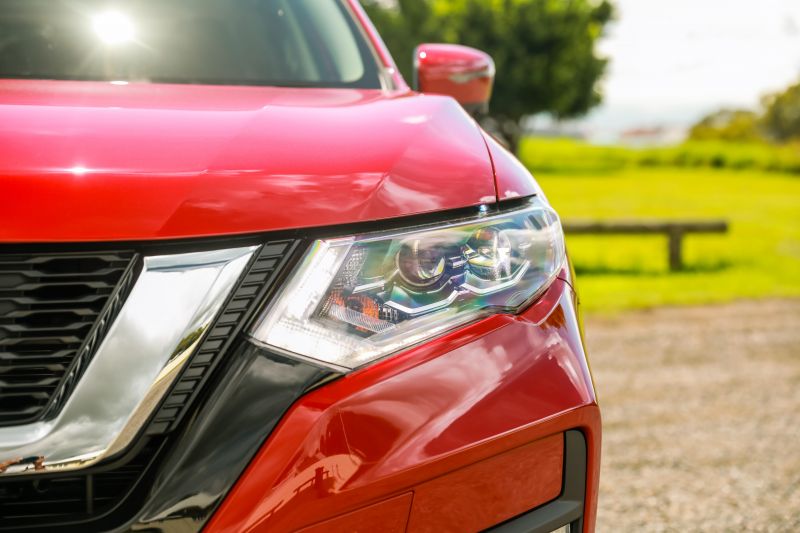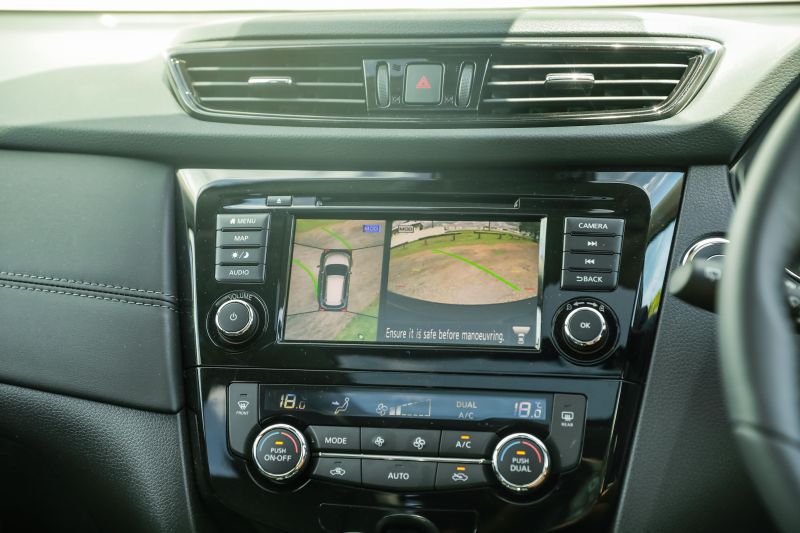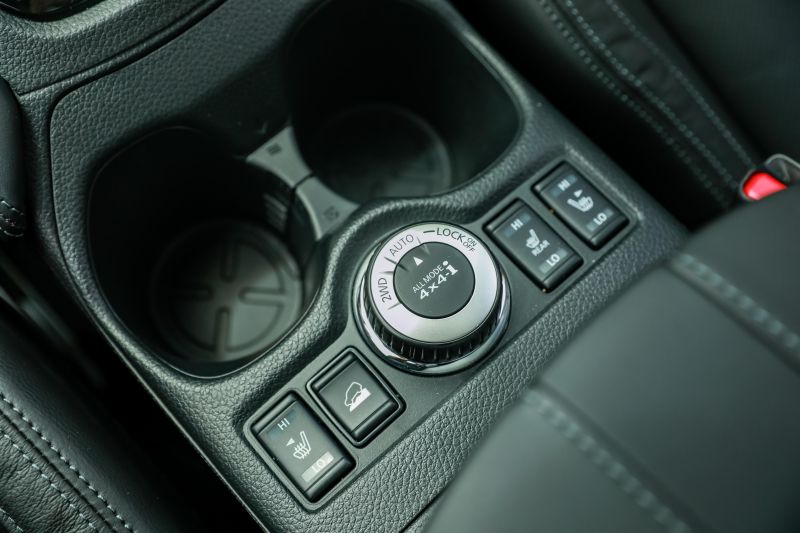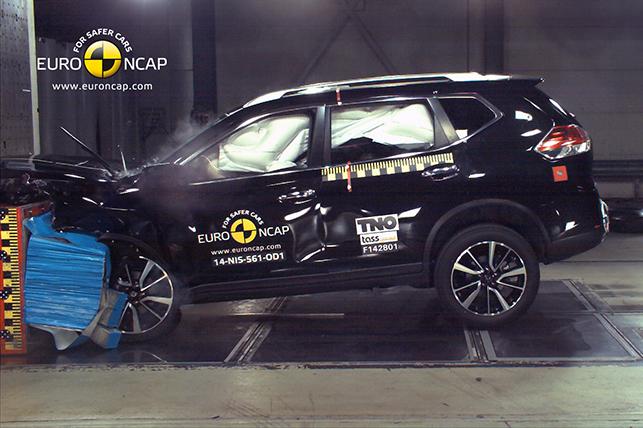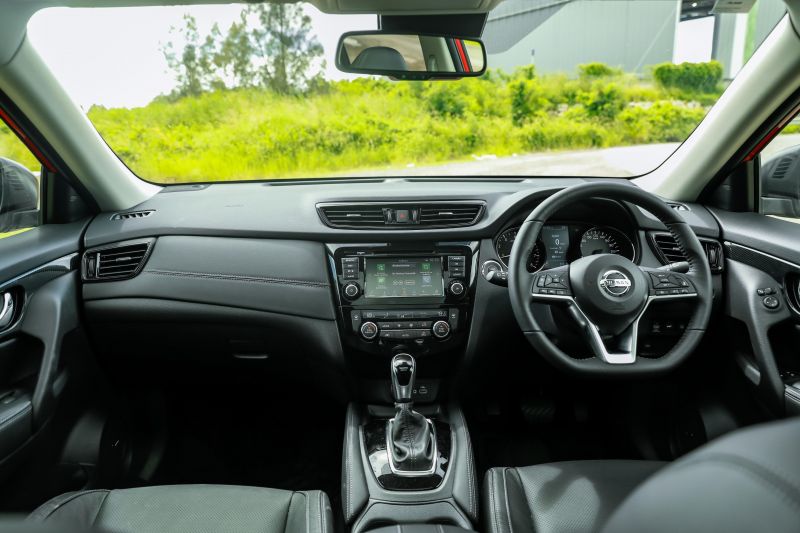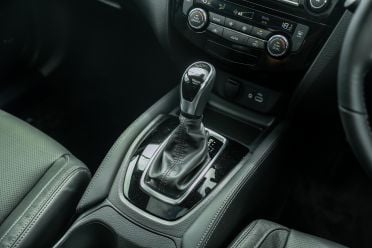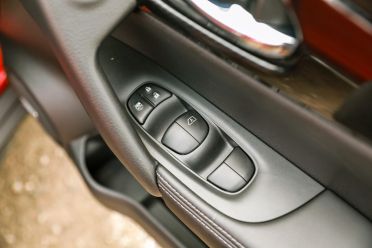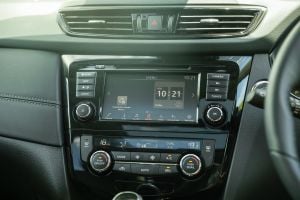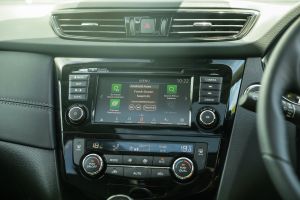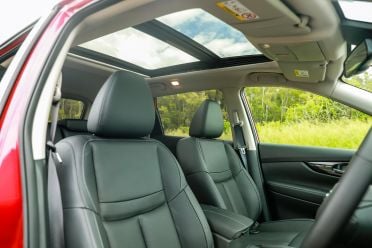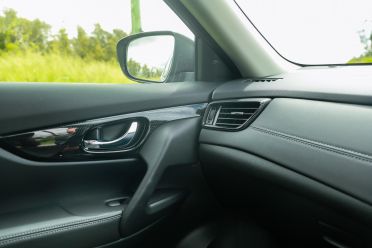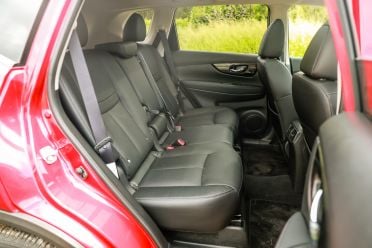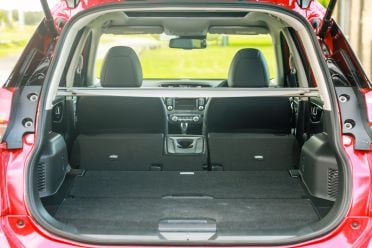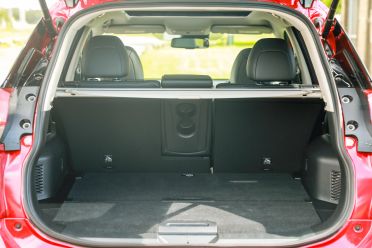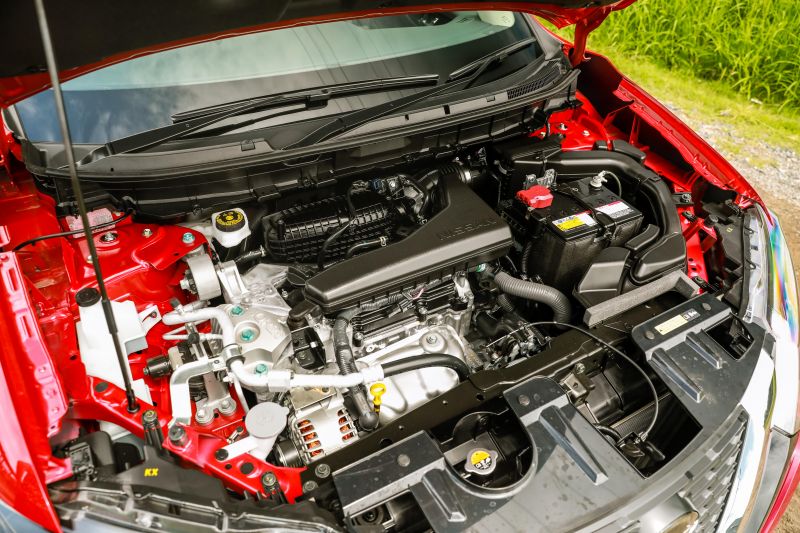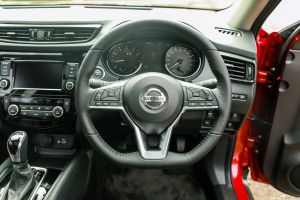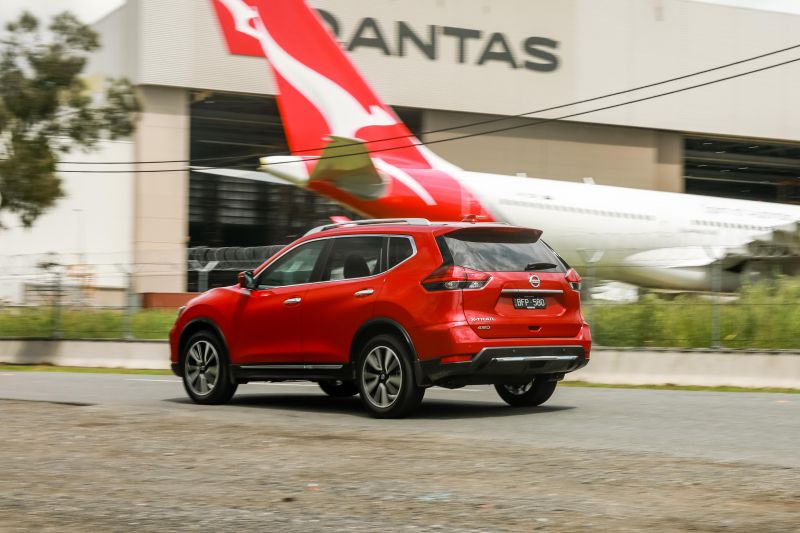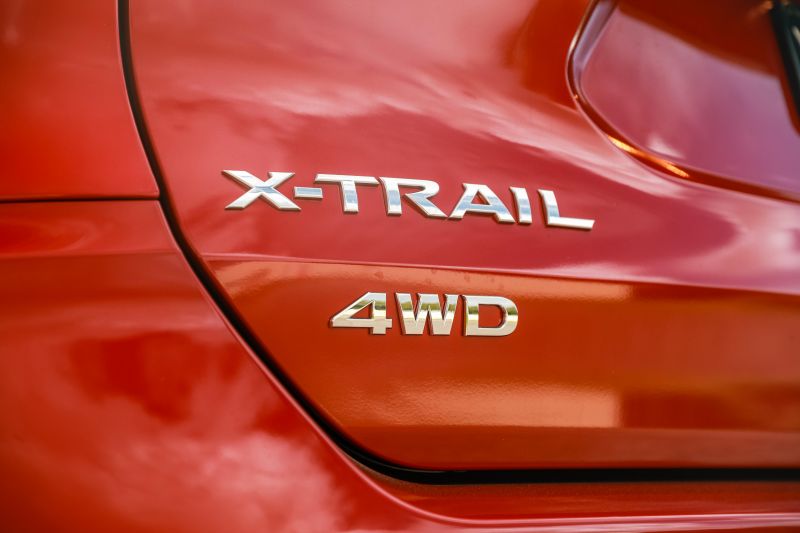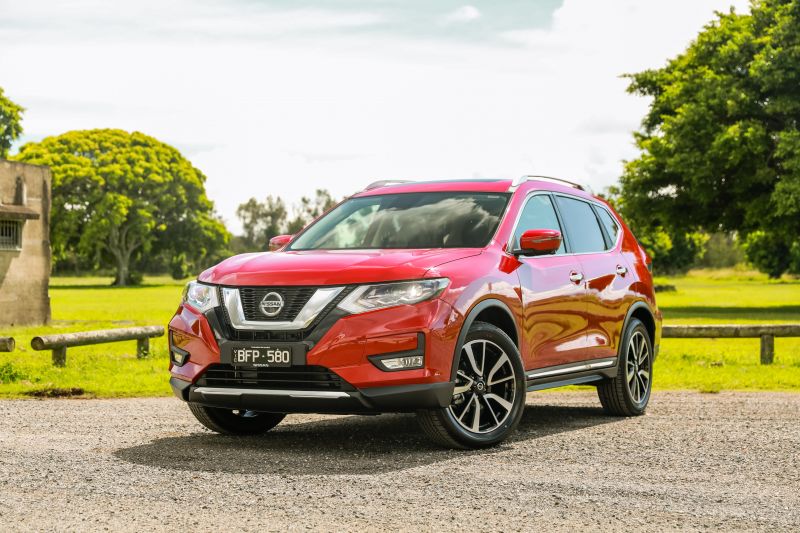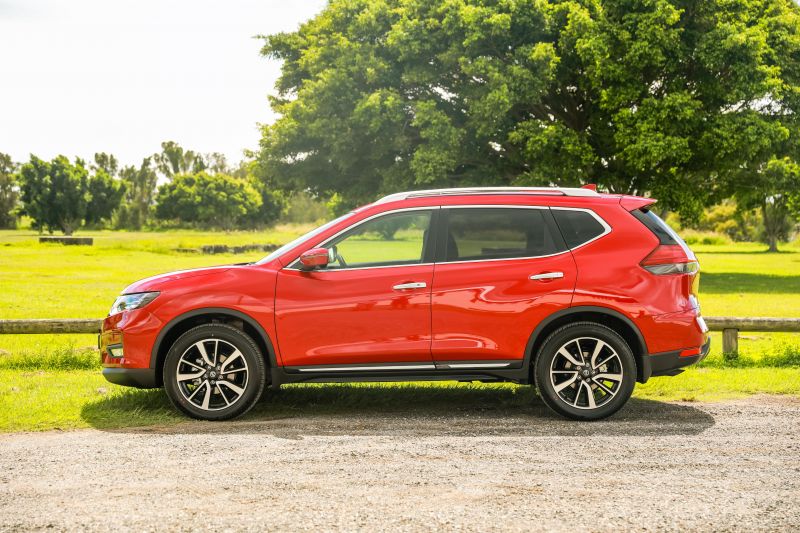If you saw the title “2021 Nissan X-Trail Ti review” and clicked on it thinking it’d be the next-generation model, we’re sorry to disappoint.
The next X-Trail won’t arrive until 2022, over 12 months after it reached North American showrooms where it’s known as the Rogue. That also means it’ll be beaten to the Australian market by the next-generation Mitsubishi Outlander, which will become its twin under the skin.
Fortunately, Nissan has given the X-Trail a minor update for 2021 to keep it fresh in Australia’s most popular vehicle segment. Wired Android Auto and Apple CarPlay are now standard across the range, while lower trim levels get a handful of extra features.
Our tester is the flagship Ti, which is $475 more expensive than last year. There’s no longer a diesel, TL-badged version, with Nissan reducing the diesel X-Trail range to a single, entry-level TS. That means if you want an X-Trail with all the fruit, your only option is a petrol engine now.
This gorgeous Ruby Red metallic paint is standard on the X-Trail, with all other colours costing $595. It complements the X-Trail quite well – the design is still stylish after seven years, thanks in part to an attractive 2017 facelift and the slick 19-inch alloy wheels.
The X-Trail’s exterior has aged well, which perhaps explains why the 2022 model is fairly evolutionary in design.

How much does the Nissan X-Trail Ti cost?
The 2021 Nissan X-Trail range starts at $30,665 before on-roads for the front-wheel drive ST 2.0-litre manual and tops out with the all-wheel drive Ti 2.5-litre at $45,965 before on-road costs.
You can get this same powertrain and all-wheel drive in an X-Trail for almost $10,000 less at $34,665 before on-roads. Nissan also offers X-Trail ST and ST-L variants with a third row of seating, though those are front-wheel drive-only.
The Ti’s pricing puts it right up against its Renault Koleos Intens AWD platform-mate ($45,790 before on-road costs).
There’s a raft of other petrol-powered, all-wheel drive rivals at this price point. These include the Toyota RAV4 Cruiser Hybrid ($46,415 list), Mazda CX-5 GT 2.5 ($46,990 list), the outgoing Hyundai Tucson Highlander 1.6T ($46,850 list), Kia Sportage GT-Line ($45,590 list) and Honda CR-V VTi LX ($48,500 list).
More affordable options include the Mitsubishi Outlander Exceed ($43,990 list), Subaru Forester 2.0i-S ($43,490 list) and the new 2.0-litre turbo-powered MG HS Excite X and Essence X ($37,990 and $42,990 drive-away).
If you’re willing to sacrifice some of the luxury mod-cons, you can get a Volkswagen Tiguan 132TSI Life for $43,690 before on-roads or its seven-seat platform-mate, the Skoda Kodiaq 132TSI, at $46,390 before on-road costs.
There’s also the new Ford Escape. While there’s no all-wheel drive model at this price point, you can either save around $5000 and get an ST-Line AWD or spend around $4000 more and get a Vignale AWD. Either way, you’re getting a considerably more powerful vehicle. A front-wheel drive Vignale sits right in the middle of those two options.
Suffice it to say, there’s no shortage of options at this price point.
What do you get?
The Ti adds features not available on lesser X-Trail models, but some of these are becoming common in even entry-level rivals.
For example, the Ti is the only X-Trail to include LED headlights and adaptive cruise control as standard but these are standard on all Subaru Forester and Toyota RAV4 models. The Forester also includes similarly clever active cornering lights to the X-Trail Ti.
Cheers to Nissan for including a surround-view camera, but jeers for not including front parking sensors. Instead, there are only sensors at the rear.
The X-Trail Ti also misses out on some other features found in rivals, such as paddle shifters and wireless phone charging.
Over lesser X-Trail models, the Ti adds pedestrian detection for the X-Trail’s autonomous emergency braking system plus:
- Automatic high-beam
- Rain-sensing wipers
- Heated rear seats
- Heated steering wheel
- Motion-activated power tailgate
- Eight-speaker Bose sound system
- Panoramic sunroof
- Hill descent control
That’s in addition to features found lower in the X-Trail range, which includes:
- 7.0-inch touchscreen infotainment system with satellite navigation and wired Apple CarPlay/Android Auto
- Automatic headlights
- Heated and cooled cupholders
- Leather upholstery
- Leather-wrapped steering wheel
- Heated, power-adjustable front seats
- Dual-zone climate control
- Front fog lights
- Rear privacy glass
- Keyless entry and start
While it’s a much lower-volume vehicle, the Koleos makes a compelling value play. For essentially the same price as an X-Trail, with which it shares its powertrain, the Koleos Intens AWD adds a larger, 8.7-inch touchscreen, a semi-autonomous parking assist system, ventilation for the front seats, massaging for the driver’s seat, and interior ambient lighting.
Is the Nissan X-Trail Ti safe?
The Nissan X-Trail has a five-star ANCAP safety rating based on testing conducted in 2017.
It scored 14.68 out of 16 in the frontal offset test, 16 out of 16 in the side impact test, two out of two in the pole test, and offers acceptable pedestrian protection and good whiplash protection.
The Ti comes standard with the following safety features:
- Autonomous emergency braking with pedestrian detection
- Driver attention monitoring
- Blind-spot monitoring
- Rear cross-traffic alert
- Adaptive cruise control
- Surround-view camera
The AEB works at speeds of between 5 and 80km/h when it detects a vehicle and between 10 and 60km/h with pedestrians.
What is the Nissan X-Trail Ti like on the inside?
The X-Trail’s interior should be familiar to anyone who has ever sat in a mid-2010s Nissan, with a dashboard design similar to that of the Navara, Qashqai and defunct Altima which all debuted around the same time.
That means there are some dated touches, like a foot-operated parking brake when most rivals have switched to an electronic one. The power windows only have automatic up/down for the driver’s window, while some of the switchgear on the driver’s door doesn’t have backlighting.
The rubberised tray at the bottom of the centre stack is too small to properly fit many new smartphones, too, while the vaguely carbon-fibre-looking trim on the doors like it came straight out of my old 2009 Ford Falcon G6E.
Orange backlighting has become a Nissan signature, even if it does remind us of a 2004 Murano. The X-Trail’s use of orange makes the black-and-white climate display look out-of-place.
The blind-spot monitoring light is also orange but is mounted on the A-pillar trim, not on the exterior mirrors as on most rivals. It’s surprisingly dim and can be easy to miss.
Then there’s the infotainment screen. At 7.0 inches, it’s now one of the smallest in the class. We’ve been spoiled by ever larger screens and so the X-Trail’s screen feels fiddly, particularly when you’re using smartphone mirroring.
The factory navigation allows you to “pinch” the screen to zoom in and out but always goes to add a waypoint while you’re doing it, unlike on Google Maps.
Nissan’s latest user interface features on the system and it’s fairly easy to navigate, if a bit cluttered looking. We don’t know how many people will want to customise their widgets, either, though the navigation system graphics are legible and quite colourful. It’s like route guidance by Scholastic.
There are some nice materials in the interior, while everything else seems hard-wearing. The flat-bottomed, leather-wrapped steering wheel looks and feels good.
The dash top is soft plastic, though the rest of the dash is Navara-grade plastic but for a strip of leatherette trim on the passenger side. The tops of the front doors are finished in soft plastic but there’s no leatherette to break up the expanse of plastic underneath.
You sit in big, squishy leather seats that are comfortable and supportive over long distances. In the Ti, Nissan also adds some leatherette padding to the sides of the centre console which both breaks up the black plastic and makes the console comfortable to rest your leg against.
Nissan offers a tan leather interior option in the Ti, a welcome pop of colour in a segment dominated by black interiors. We hope this option continues in Australian-spec 2022 X-Trails as it has in the North American Rogue.
The panoramic sunroof makes the black-on-black interior feel a little more light and airy and it was rattle-free. The actual part that opens is a bit small, though, with the bar further forward than on some rival panoramic roofs. At least Nissan offers a panoramic roof, something some rivals (Outlander, CX-5, RAV4 Hybrid) do without.
We appreciate the large, leatherette-covered centre console bin and the logical control layout, including an easy to access day/night mode button for the instrument cluster. The cluster itself is also clean and simple, with a neatly-presented and well-sized centre information screen.
The roof drops down slightly at the rear due to the Ti’s panoramic sunroof, though this is ahead of where your head is positioned when you’re sitting in the back.
Nevertheless, taller passengers might find there to be a little less headroom than some rivals, though there’s plenty of legroom.
Nissan says headroom with panoramic sunroof is up to 1004mm/930mm, compared to 1057mm/978mm in models without one.
There are also fewer amenities back here when compared to rivals. There are rear air vents, and map pockets, as well as bottle holders in each door large enough for a 1L bottle and a couple of cupholders in the fold-down centre armrest.
While there are two USB outlets up front, there are none in the rear of the cabin. There’s also no 12V outlet back here. Despite the presence of heated rear seats, there are also no rear controls for these. Instead, these can only be controlled via a switch in the front.
Cargo capacity is 565L, expanding to 945L with the second row folded. Nissan works on a different measurement system than most rivals, evidently, as even the related Renault Koleos boasts 458L and 1690L, respectively.
The boot has a cargo cover that looks discoloured, while underneath the load floor is a space-saver spare.
We experienced a couple of issues inside the cabin. A rattle seemed to be emanating from the tailgate, while the sound system produced this kind of static noise whenever we weren’t playing music. Turning the volume to zero didn’t get rid of this.
What’s under the bonnet?
The X-Trail Ti, as with almost all X-Trail models, is powered by a naturally-aspirated 2.5-litre four-cylinder engine producing 126kW of power and 226Nm of torque, mated with a continuously variable transmission (CVT). The Ti features all-wheel drive.
Braked towing capacity is 1500kg, only 150kg less than the diesel TS, while unbraked is 750kg.
The X-Trail has 210mm of ground clearance.
How does the Nissan X-Trail Ti drive?
The Nissan X-Trail is like an old shoe. It’s utterly familiar and mostly comfortable, though this old shoe has thinner soles than some.
Ride quality with the 19-inch alloy wheels is so-so. While it’s rarely crashy, it’s busy even on smooth stretches of tarmac and manages to find imperfections in the road you didn’t even realise were there.
That firm ride doesn’t correspond with sporty handling, with the X-Trail having a fair amount of body roll in corners. Handling always feels safe and predictable, however, and switching to all-wheel drive Auto mode helps get the X-Trail’s modest outputs to the ground more effectively in wet or snowy conditions by splitting torque by up to 50:50 between the front and rear wheels.
An additional Lock mode fixes the torque distribution until you reach higher speeds.
The firm ride detracts from an otherwise comfortable driving experience. The big, cushy front seats prove supportive over long distances and the leather-wrapped steering wheel feels good in your hands.
The steering itself has good weighting – it’s heavier than the related Renault Koleos but it’s still nice and light for inner-city manoeuvring.
The brakes don’t really feel up to the task of stopping this 1562kg (tare) vehicle, with a spongy brake pedal and stopping distances that feel too long.
A CVT is a perfectly acceptable transmission choice for a vehicle like this and it works to keep the car within its peak torque and power band (4400rpm and 6000rpm, respectively). It helps make the X-Trail feel relatively peppy off the line, though the Nissan feels taxed by steeper hills even with only one occupant aboard.
There’s the typical slurring sound you’ll find in many vehicles with CVTs and the X-Trail can get a bit vocal under hard acceleration, but for the most part the Nissan doesn’t sound strained. It doesn’t sound sporty, either, but this isn’t the worst vehicular soundtrack. It’s also fairly quiet on the highway.
There’s a manual mode you can use by pushing and pulling the shifter. It does a vague approximation of a regular automatic but we don’t know why you’d bother, except on steeper grades.
The Intelligent Lane Intervention, as Nissan calls it, isn’t like the lane-keeping assist systems you’ll find in newer rivals. There’s no steering assistance and it only works above 70km/h.
It works by applying brakes to the left or right wheels individually when you’re veering out of a lane, but in practice it’s virtually useless.
One feature that does work consistently well is the adaptive LED lighting up front, a rarity in this segment. The beam of the headlight moves with the steering wheel, helping illuminate around corners.
How much does the Nissan X-Trail Ti cost to run?
Nissan covers the X-Trail with a five-year, unlimited-kilometre warranty and offers six years of capped-price servicing. Services are required every 12 months or 10,000km – a bit short for the segment, especially against the Koleos’ 12-month/30,000km intervals
The first six services are capped at $245, $378, $255, $496, $265 and $410, or an average of $341 per service. That’s competitive with most rivals, some of whom may offer cheaper services but offer fewer capped-price ones (Escape, RAV4).
Over a mix of inner-city, highway and suburban driving, we averaged 9.0L/100km. Over the course of a week, that crept up to 10.5L/100km. For comparison, the advertised combined fuel economy rating is 8.3L/100km.
The X-Trail runs on 91RON regular unleaded fuel and has a 60L fuel tank.
CarExpert’s Take on the Nissan X-Trail Ti
In a vacuum, the Nissan X-Trail Ti looks like a solid mid-sized SUV buy. Busy ride aside, it’s easy to drive and has enough power for most situations.
The interior looks old but it doesn’t look cheap, while the Ti packs a good amount of standard kit. And personally, while I’m not the number one CVT fan, I didn’t mind the way the Nissan drove.
Alas, it doesn’t compete in a vacuum. Quite the opposite: this is the big leagues, the best-selling passenger car segment in Australia. While the X-Trail looks nicer inside and out than the other segment veteran, the Mitsubishi Outlander, its crosstown rival at least undercuts similarly-equipped rivals by a few thousand dollars.
The X-Trail doesn’t. Instead, it’s priced head-on with a raft of newer, fresher rivals that offer features even this range-topping Nissan doesn’t have like front parking sensors, semi-autonomous parking assist, and a lane-keeping assist system that actually works.
The Nissan even has tough competition coming from inside the Renault-Nissan-Mitsubishi alliance, with the Koleos Intens offering more equipment and a fresher interior at the same price. Considering you can get an almost completely loaded RAV4 Cruiser AWD Hybrid for only $500 or so more, it really highlights how much the X-Trail Ti’s value proposition has evaporated.
The X-Trail isn’t a bad car by any means, but there are just too many good and better cars in this segment. Unless you can get a really good deal, you’d be better served by any number of those rivals, or by waiting for the 2022 model.

